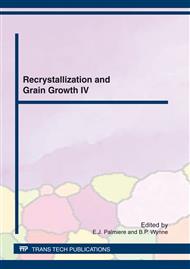[3]
1 Flow Curves Flow curves at temperatures of 900~1200oC were recorded under a wide range of strain rates, 0. 1~42/s, and shown in Fig 1. The strain rates of 0. 1~1/s are usual in the laboratory experiments; while 10~40/s are in the range of actual strain rates in the industrial hot rolling line. It can be seen that all flow curves show single peak during compression, indicating occurrence of dynamic recrystallization after the initial work hardening and dynamic recovery. The data of peak strain and peak stress, which is supposed to be the onset of dynamic recrystallization, can be determined from flow curves and plotted in Fig. 2. It can be clearly seen that HNSSes show remarkably higher flow stress than the commercial AISI 304, and the flow stress increases markedly with increasing content of nitrogen, particularly at low temperature; whilst the peak strain appears to decrease with increasing nitrogen. Moreover, it changes little with varied strain rates at 900oC, but does increase at higher strain rate at 1100oC. (a) Steel 1 compressed at temperatures of 900~1200oC with strain rates of 0. 1~42/s (b) Steel 2 compressed at temperatures of 900~1200oC with strain rates of 0. 1~42/s Fig. 1 True strain-true stress curves during hot compression on Steels 1 and 2.
Google Scholar
[3]
2 Microstructures The microstructures after isothermal holding at 1200oC for 20 minutes are show in Fig. 3. The steel with 0. 51%N contains approximately 5% delta-ferrite (dark phase in Fig. 3(a), which was measured by both optical microscopy and ferromagnetic instrument, while the 1. 08%N containing steel consists of single austenitic phase, as shown in Fig. 3(b). Figure2 Dependence of peak stress and peak strain, measured from flow curves in Fig. 1, on nitrogen content, temperature and strain rate Fig. 3 Microstructures on the specimen quenched from 1200oC after 20 minutes (a) Steel 1 (b) Steel 2 Fig. 4 gives examples of microstructures after deformation at different temperatures with varied strain rates. At 1100oC, deformed grains seem restored by a typical continuous recrystallization. In addition, some grains look much coarser than other when the strain rate is 0. 1/s, indicating that they are not recrystallized during deformation; while at the intermediate strain rate of 1/s, such coarse grains disappear and almost all grains are refined to a small size by dynamic recrystallization; at the highest strain rate of 10/s, all grains have been recrystallized but grain size seems coarser than that at 1/s. At 900oC, only partial recrystallization was observed, particularly, less deformed grains are recrystallized at lower strain rate; moreover, recrystallization was initiated at the deformed austenite grain boundaries, and the recrystallized zone got thickening with the proceeding recrystallization, leading to formation of so called necklace-like structure. In addition, it is not surprising to find that recrystallized grains are finer when the deformation temperature decreases from 1100oC to 900oC. Because the partial recrystallized microstructures at 900oC are too fine to be resolved by the optical microscopy, the microstructures were examined by TEM. It can be found that some regions with highly dense dislocations and sub-micrometer newly-formed grains was also observed, inside which mobile dislocations tend to form rough sub-boundaries, as seen in Fig. 5. Surprisingly, not so many twining and planar slip were found. To track the evolution of recrystallized microstructures during deformation, misorientation mapping was performed by EBSD on Steel 1 deformed to different strains of 0. 25, 0. 6 and 0. 9, and the results are given in Fig. 6. At a level of small strain, newly formed high-angle boundaries are occasionally found at some strain-concentrated regions; fraction of high-angle boundaries increases with strain, most along the primary grain boundaries and almost parallel to the tensile direction. Meanwhile, low-angle boundaries are also developed inside the deformed grains. (a) (b) (c) (d) (e) (f) Fig. 4 Optical microstructures of Steel 1 quenched immediately after deformation (a)by 0. 1/s at 1100oC; (b)by 1/s at 1100oC; (c)by 10/s at 1100oC; (d)by 0. 1/s at 900oC; (e)by 1/s at 900oC; (f)by 10/s at 900oC; Fig. 5 Microstructures of Steel 1, quenched after deformation at 900oC by 1/s to a strain of 0. 6, by TEM. e=0. 25 e=0. 6 e=0. 9 Fig. 6 EBSD misorientation map for the microstructures of Steel 1, quenched after deformation at 900oC by 1/s to different strains, where black>15o, red>10o, green>5 and blue<5o.
Google Scholar
[4]
Discussion High nitrogen stainless steel exhibits much higher deformation-resistant force during hot working than the commercial austenitic AISI304 stainless steel, and its strength is raised with increasing content of nitrogen (Fig. 2), which is consistent with many previous observations[] V. G. Gavriljuk, H. Berns, C. Escher, N. I. Glavatskaya, A. Sozinov. Materials Science and Engineering, A271(1999).
DOI: 10.1016/s0921-5093(99)00272-5
Google Scholar
[5]
Conclusions Softening mechanism of high-nitrogen stainless steels were studied with a wide strain rate at different temperatures, some conclusions may be drawn: (a) The flow stress curves show the typical single-peak characteristic in the investigated ranges of strain rate and temperature, indicating the onset of dynamic recrystallization during deformation. (b) A complete recrystallization can only be achieved at high deformation temperature, and high strain rate leads to more grains recrystallized. A continuous dynamic recrystallization was observed at high temperature with low strain rate. Whilst a necklace-like partial-recrystallized microstructure was observed at low deformation temperature. (c) Experimental results indicate that post-deformation softening, meta-dynamic or static recrystallization, has a strong tendency to take place in the actual industrial rolling line with much high strain rate for HNSS.
DOI: 10.1016/j.vacuum.2017.11.007
Google Scholar


